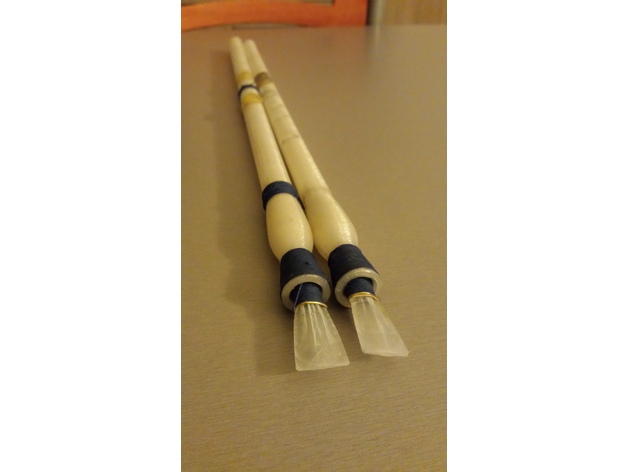
Louvre Aulos
thingiverse
Reproduction of the Louvre Aulos (Version 3) : I've corrected the diameter of the holes (now they're oval as the original), and updated the joints. In the version 2, they're provided with a seat for cork or thread, to ensure a better sealing and avoid leaks as much as possible! But this wasn't enough and, instead I decided to take inspiration from the Classical era auloi (Pydna/Poseidonia) which are made out of many deer bone sections joined with slightly conical spigots. I use ordinary paper on the joints that are slightly loose. You can check the measurements made and published by Stefan Hagel and compare them to those of your print as a starting point from where you can fine tune the instrument : https://www.researchgate.net/publication/316277175_Better_understanding_the_Louvre_Aulos The two pipes (High and Low) of the Louvre Aulos have been modeled and divided in 3 parts (Mouthpiece, Middle and Bell). The lowest note should be between F and F# with a pitch of around 182 Hz, but, depending on the used reeds, the pitch can change. Good rules are : The Low pipe should give an octave between its lowest note (all holes closed/stoped) and its highest note (first from top hole open) ¡Without any modification of air pressure or embouchure! The High pipe with all the holes closed should give the unison with the lowest note of the Low pipe AND opening the first from the top hole of the two pipes, give a perfect fourth (High pipe : b natural (a little bit flat), Low pipe : f# (a little bit flat). The other internal relations should normally be in tune and can relatively easily be corrected with bee's wax or (sandpaper in this case). The 3d printable plastic reed I've provided has been removed because the experiments I've ran did not provide reliable enough results and thus are not worth to be downloaded. However, if some of you are interested in continuing the experiment I'll be happy to send you by private e-mail the Solidworks or stl files of the successive 3d printed bocal and blades versions. Instead, and because there are more and more good aulos reedmakers around the world, I provide here two models of printable reed-former (used while forming/crafting the reed from cane) AND reed-cap (used to protect the reed when non played, a little but like the duduk reeds). Likewise, if you're interested in modify any aspect of these files I'll provide the original Solidworks files if requested by private e-mail or message. Print the formers and caps two by two vertically (the file only have a half of the object) and use the small ridges to tie the two halfs firmly with waxed thread. There is another file which is a former for the reed tail's inverted cone that enters in the reed-insert of the instrument. They are designed to provide a sort of mold in which the maker can place the hot boiled cane and push step by step. The small obus form inside of the mold has a double function, it prevent's the reed from cracking when pushing it into it's reed-insert former (because the walls of the reed tube are compressed on the two sides) AND, a prevents also the reed from bending because the protruding shape mimics the interior of the reed making it more resistant (some soft reeds tend to bend as they get softer when boiled). A document on how to prepare the reeds out of cane is in process. Enjoy and Thank you! Print Settings Printer Brand: Velleman Printer: K8400 Rafts: No Supports: Yes Resolution: 0.1 to 0.2 mm Infill: 100 % Notes: Paradoxically, I've noticed that the best way to print the parts are vertical starting with the spigot AND using supports "only from the build plate". Post-Printing With the version 3, some spigots may need some sanding to fit properly and some may require the use of a thin strap of ordinary paper (newsletter also). Before tying the formers and caps, don't forget to smooth the internal surface with sandpaper in order to avoid the reed hit some irregularities. Don't hesitate to re-drill some of the holes or the main bore to bring it closer to the original measurements.
With this file you will be able to print Louvre Aulos with your 3D printer. Click on the button and save the file on your computer to work, edit or customize your design. You can also find more 3D designs for printers on Louvre Aulos.
